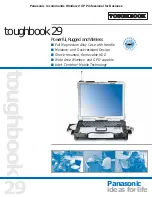
24
EN
IN USE
After connecting to the mains power, the display will briefly indicate the
adjusted charging
setting by way of a number and one or more led’s under
‘charge process’ will light up.
At the start of the charging process the TBC 600
first checks the battery voltage. If the battery voltage is not correct then an
error indicator will indicate this.
The charging process consists of 5 phases at most, depending on the charging
program. The length of the charging time depends on the battery quality,
battery capacity, depth of discharge and the current draw of any present
users. Furthermore any faults could delay the process. A short description of
each charging phase:
1. Boost = T1
Every charging session begins with this phase, whether the battery is full or
not. With a discharged battery, the charging current is 100% and the voltage
increases until the set voltage is reached. The boost charge always takes at
least 30 minutes. As such, even if a full battery is connected this phase always
takes 30 minutes.
During this phase the red LED under ‘charging process’
lights.
2. Equalize = T2
The charging current is at most 100%, but because the battery is filling up the
charging current decreases. The charging voltage is at a maximum. The point
at which the following phase is entered depends on the charging program
(based on time or on a percentage of the charging current). However, this
charge phase always has a duration of maximum 4 hours, without any thermal
stops which may occur. During this phase the yell
ow LED under ‘charging
process’ lights.
3. Compensate = T3
This is a special and extra phase for breaking down the sulphates which build
up when the battery is (deeply) discharged on a regular basis. The voltage can
increase to 16Volt. As such, this
phase is only used in ‘stand alone’
applications (no users present during the ch
arging process). This phase isn’t
suitable for most sealed, maintenance free batteries. The compensation phase
lasts at most 4 hours, plus any thermal stops which may occur. During this
phase the yellow LED under ‘charging
process’ bl
inks.
4. Float = T4
The battery is full and is mainteananced with a lower, stable voltage of 13.5Volt
or 13.8Volt, depending on the charge setting. During this phase, the charger
can still supply its maximum current without the charger going into the boost
phase. Because of this the TBC 600 is capable of supplying other devices
when used ‘on board’. If the battery voltage drops below 12.65 Volt for a
longer period of time, the charger automatically switches back to the boost
phase (T1). During this phase the green LED
under ‘charging process’ lights.
5. Jogging = T5
If, during float charging, the charging current is less then 10% for more than
24 hours, the charger switches over to jogging. This phase prevents a battery,
which has been on float charge for a long t
ime, from becoming “lazy”. During
this phase no charging current is delivered. If the battery voltage drops below
12.65 Volt the charger automatically switches back to the boost charge phase
(T1). During this phase the green LED under
‘charging process’
blinks.
















































